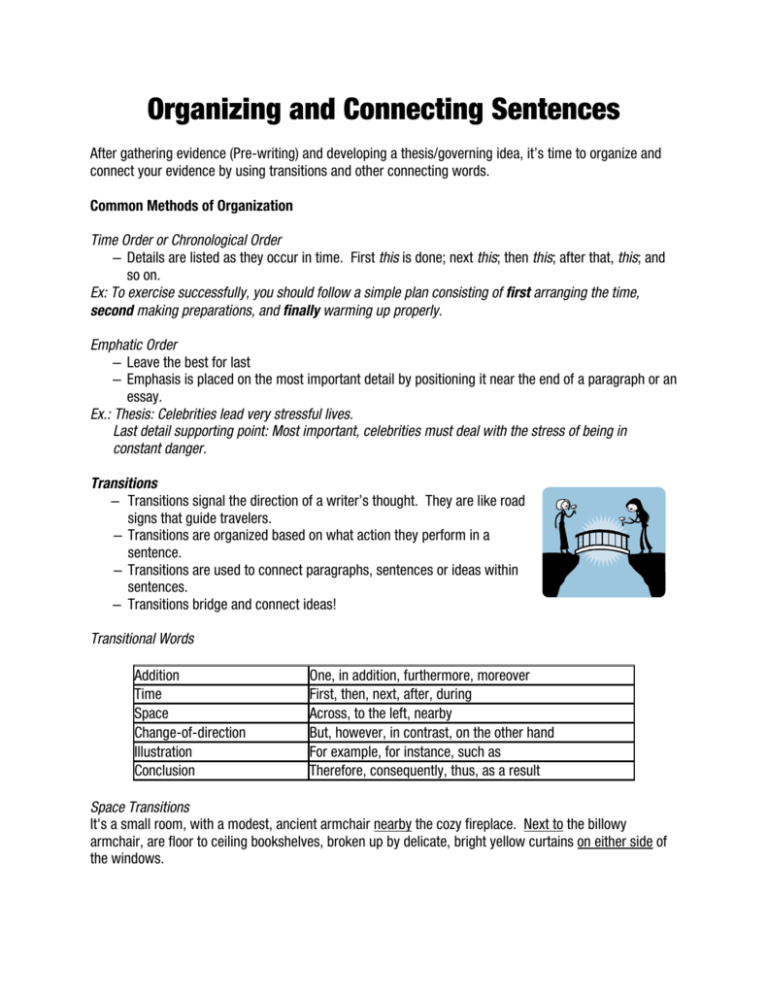Organizing and Connecting Sentences
advertisement

Organizing and Connecting Sentences After gathering evidence (Pre-writing) and developing a thesis/governing idea, it’s time to organize and connect your evidence by using transitions and other connecting words. Common Methods of Organization Time Order or Chronological Order – Details are listed as they occur in time. First this is done; next this; then this; after that, this; and so on. Ex: To exercise successfully, you should follow a simple plan consisting of first arranging the time, second making preparations, and finally warming up properly. Emphatic Order – Leave the best for last – Emphasis is placed on the most important detail by positioning it near the end of a paragraph or an essay. Ex.: Thesis: Celebrities lead very stressful lives. Last detail supporting point: Most important, celebrities must deal with the stress of being in constant danger. Transitions – Transitions signal the direction of a writer’s thought. They are like road signs that guide travelers. – Transitions are organized based on what action they perform in a sentence. – Transitions are used to connect paragraphs, sentences or ideas within sentences. – Transitions bridge and connect ideas! Transitional Words Addition Time Space Change-of-direction Illustration Conclusion One, in addition, furthermore, moreover First, then, next, after, during Across, to the left, nearby But, however, in contrast, on the other hand For example, for instance, such as Therefore, consequently, thus, as a result Space Transitions It's a small room, with a modest, ancient armchair nearby the cozy fireplace. Next to the billowy armchair, are floor to ceiling bookshelves, broken up by delicate, bright yellow curtains on either side of the windows. a modest, ancient armchair billowy armchair bright yellow curtains the cozy fireplace. floor to ceiling bookshelves windows Change of Direction Transitions History, despite its wrenching pain, cannot be unlived, however, if faced with courage, need not be lived again. –Maya Angelou History, despite its wrenching pain, cannot be unlived if faced with courage, need not be lived again. Conclusion Transitions Our problems are man-made, therefore they may be solved by man. And man can be as big as he wants. No problem of human destiny is beyond human beings. –John F. Kennedy Our problems are man-made they may be solved by man. Illustration Transitions Any great truth can -- and eventually will -- be expressed as a cliche -- a cliche is a sure and certain way to dilute an idea. For instance, my grandmother used to say, 'The black cat is always the last one off the fence.' I have no idea what she meant, but at one time, it was undoubtedly true. –Solomon Short Any great truth can -- and eventually will -be expressed as a cliche -- a cliche is a sure and certain way to dilute an idea. my grandmother used to say, 'The black cat is always the last one off the fence.' I have no idea what she meant, but at one time, it was undoubtedly true. Repeated Words – Repeat only key words. Remind the reader of your focus, your subject. – Repeating key words helps tie together the flow of thoughts in a paper. We know that polls are just a collection of statistics that reflect what people are thinking in 'reality.' And reality has a well known liberal bias.—Stephen Colbert We know that polls are just a collection of statistics that reflect what people are thinking in 'reality.' And reality has a well known liberal bias. Pronouns – Pronouns can help you avoid unnecessary repetition. – Common Pronouns: he, she, it, they, this, that, me, I, who, whom Any reviewer who expresses rage and loathing for a novel is preposterous. He or she is like a person who has put on full armor and attacked a hot fudge sundae.—Kurt Vonnegut Any reviewer He or she Synonyms – Using words that have similar meanings can add variety and avoid unnecessary repetition. There are several methods of fund-raising [. . .]. One technique is to hold an auction [. . .]. methods technique






